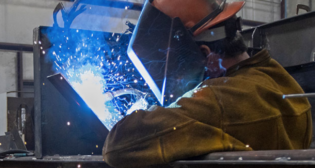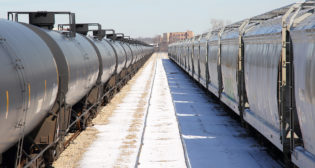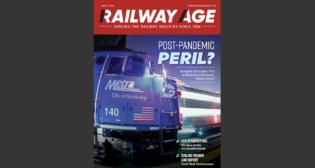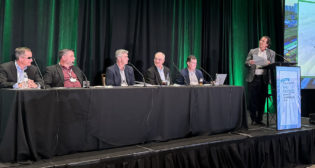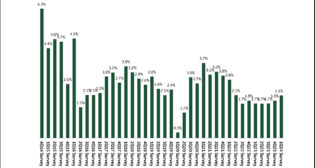
Financial Edge: Foresight, hindsight at Rail Insights
Written by David Nahass, Financial Editor
At Railway Age’s 2017 Rail Insights conference, attendees were treated to updates on a variety of current industry topics, such as the current status of Amtrak’s replacement of the Acela Express train, and a “what’s next” panel on the state of growth in North American rail freight (intermodal or bust?).
Rail Insights also offered an update on the car and locomotive lease markets. Chris Schmalbruch, President of VTG Rail, Tom Simpson, President of the Railway Supply Institute and Todd Kahn, Vice President at Chicago Freight Car Leasing Co., participated in a lively discussion on where the railcar market is headed and on the status of retrofits in certain tank railcar markets.
The railcar market remains as challenging as it has been for 2016 and 2017, with the only real change being the resurgence of the sand market and the increasing demand for small-cube covered hoppers. While acknowledging that the market for sand clearly has improved from its low point in 2015, both Schmalbruch and Kahn suggested concern about the possibility of that market again becoming oversupplied and saturated with equipment, if railcar manufacturers gear up to build another tranche of new small-cube hoppers.
The panelists echoed similar concerns about overbuilding in the covered hopper fleet for hauling grain and plastics and in the standard pressure tank railcar fleet (non TIH) for hauling LPG and NGLs. They referenced the existence of the sizeable railcar backlog and the need for railcar leasing companies to find some type of car that they can use to replace sand hoppers or tank railcars for crude.
So what will create a more balanced environment for lease rates and car demand? The panel noted that a market sitting on a significant oversupply of equipment across many product segments does not offer car owners hope for near-term rental improvement or relief. As well, decreasing the number of railcars being manufactured would be the best first step toward promoting a healthier rental environment for railcars of all types.
The panel also noted that the locomotive market is going through a period of oversupply and low rental rates. Contrary to the railcar market, there is no large backlog of locomotive orders, so the future has a less eerie halo around it. The panel did not touch on Tier IV emissions and the future impact on locomotive demand.
The panelists addressed the continued influx of new capital into the railcar marketplace. Kahn and Schmalbruch suggested that new investors seem willing to accept lower investment returns than historical averages as they break into the market. Investors viewed as overpaying for used assets expect that the value of those assets will continue to increase even as rental rates decline on that equipment. Many investors might rethink that strategy when leases for cars purchased for high prices reach expiration are renewed for materially lower rates.
The panel went on to discuss whether a lengthy period of low interest rates might have changed the historical return on investment for operating lessors. The data here remains inconclusive. The panel agreed that many of today’s new investors seem willing to spend more freely with less precision regarding the source of lease revenue for repayment. Nonetheless, our panel remained optimistic that a prudent and measured approach to investment will continue to be the correct approach, long term.
Moving to the topic of the retrofitting of tank railcars, Simpson noted that more than 5,000 have been converted from their original CPC-1232 design or from the DOT 111 “legacy” to the current retrofit specification, the DOT 117R. The panel agreed that expectations are for retrofitting to increase as the industry moves closer to the 2019 and 2023 change-out dates for cars that are not built to the DOT 117 specification.
The proximity to the specification change-out date for pressure tank railcars carrying TIH commodities was also addressed. These railcars will need replacement by 2019. More than 10,000 cars requiring replacement remain in service. Why? The recommended specification for the new car design has yet to be confirmed for a 50-year life. End users and lessors wanting to avoid another crude tank railcar design fiasco and are holding off on new car orders.
The panel concluded by discussing the pace of orders and deliveries for 2017. As the number of railcars that may be delivered in 2017 continues to creep higher, so do expectations that the number of orders placed with railcar manufacturers are expected to increase. When the RSI issues its 2Q2017 update in early July, do not be surprised by a bump in railcar orders being placed in the past 90 days.
